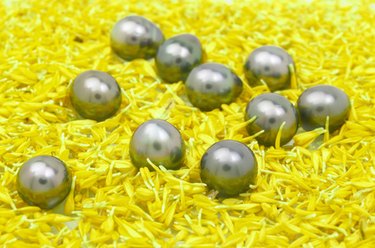Things You'll Need
Pearl
Piano hinge
Hack saw
Masking tape
Soldering pick
Jeweler's torch
Pearl drill bit, carbide tip
Dust mask
Ruler

Professional jewelers have professional level equipment for drilling pearls. But if you are an individual jeweler craftsman working out of your home studio, chances are you don't have the money nor the need for an expensive pearl drilling machine. You can manually drill pearls with a method that doesn't cost a lot of money. Pearls that are mounted on posts such as in rings or earrings are half drilled. Pearls that are strung for necklaces are drilled all the way through the center.
Step 1
Cut a small section of piano hinge with a hack saw. A 1-inch length will work nicely. Cut the section so that one of the screw holes already stamped into the hinge flanges is centered in the middle of the section.
Video of the Day
Step 2
Place strips of masking tape on the inside faces of both hinge flanges and poke a hole through the tape where it covers the holes in the hinges. The masking tape will protect the surface of the pearl from getting marred or scratched.
Step 3
Place the pearl between the two hinge flanges and close them tight against the pearl. Make sure the surface where the hole is going to be drilled is centered in the middle of one of the holes in the hinge flange. Hold the hinge flanges at the outside edges. The pearl is not firmly clamped in place.
Step 4
Take a needle tool like a soldering pick--a tool with a wood handle and a pointed steel shaft--and heat the tip with a torch until it glows orange-red. Place the hot tip of the tool on the surface of the pearl and twist it back and forth. This will create a small dimple in the surface of the pearl. The dimple will give the drill bit something to grab on to when it starts spinning. Without this dimple, the drill bit will slide over the surface of the pearl, possibly damaging it.
Step 5
Lock a pearl drill bit into the chuck of a flexible shaft machine. This machine has variable speed and different bits can be used with it.
Step 6
Put on a dust mask. Gripping the hinge tight against the pearl with the non-dominant hand, place the tip of the drill bit on the dimple created in Step 4 and start the drill. Drill at a fairly high speed and every few seconds back the drill out of the pearl a bit so the pearl dust can release from both the hole and the drill bit. Drill through the pearl.
Step 7
Wrap masking tape around the drill bit as a marker for half-drilled pearls. Measure from the tip of the drill bit up its shaft the total depth of the hole to be drilled, and place a strip of masking tape around the shaft of the drill bit at this measurement. When the edge of the tape is even with the surface of the pearl, it's drilled halfway through.
Tip
You can use a regular drill bit to drill pearls if you drill at a high speed and apply little pressure while drilling, but these drill bits won't last long.
Warning
Use carbide drill bits with care at high speeds as they are brittle and easily broken.
Video of the Day